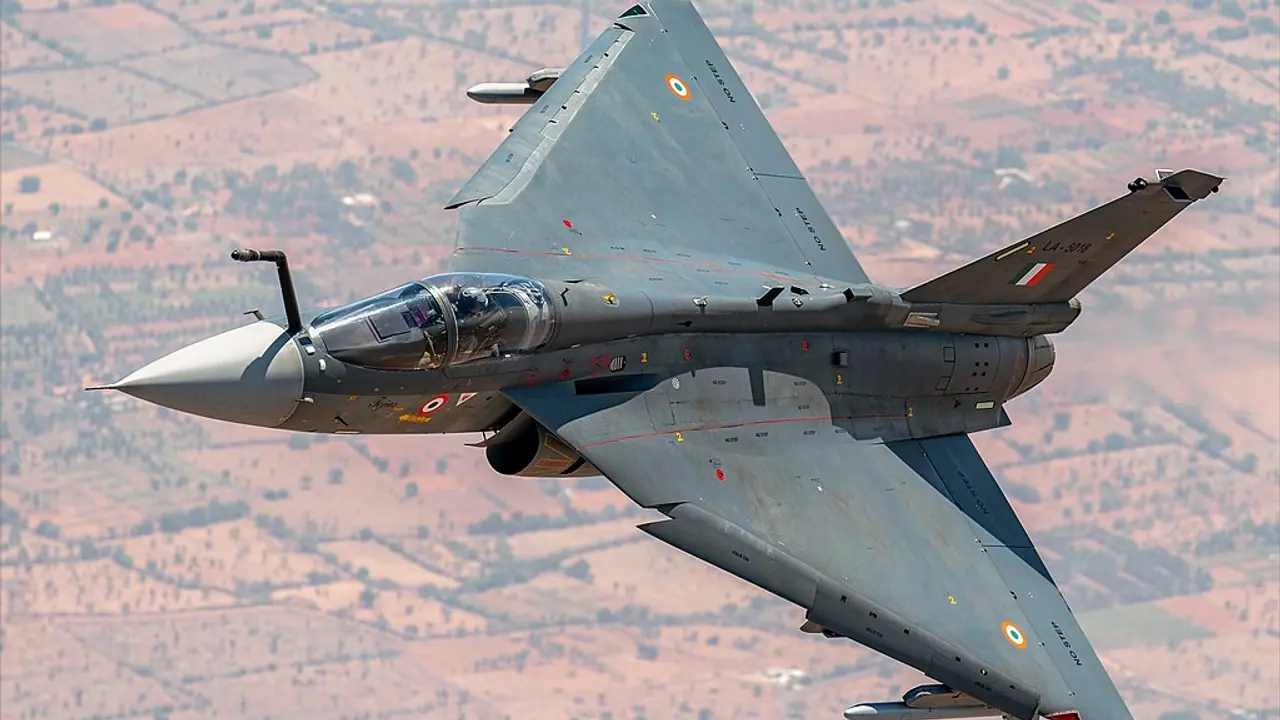Armed with Astra missiles, HAL’s Tejas Mk1A establishes India’s aerial dominance over Pakistan’s ageing F-16s and JF-17s. With superior tech, firepower, and growing production, Tejas is India’s ultimate deterrent and symbol of self-reliance.
India’s homegrown HAL Tejas Mk1A, armed with the deadly Astra missile, is no longer just a fighter jet—it’s a bold statement of power that sends shivers down Pakistan’s spine. With its cutting-edge tech and lethal firepower, this beast is ready to dominate the skies and put Pakistan’s ageing F-16s and JF-17s in their place.

Hindustan Aeronautics Limited (HAL) has delivered a machine that not only matches but outclasses Pakistan’s air force, ensuring India’s iron grip on aerial supremacy. Here’s why the Tejas Mk1A is the ultimate deterrent Pakistan cannot ignore.
First, let’s talk firepower. The Astra Mk-1 missile, proudly made in India by the Defence Research and Development Organisation (DRDO), is a beyond-visual-range (BVR) killer with a 100–110 km range, zooming at Mach 4.5 to smash enemy jets before they even see it coming.
Successfully test-fired from a Tejas Mk1 prototype on March 12, 2025, off Odisha’s Chandipur coast, the Astra scored a direct hit on a moving target, proving its deadly precision. Unlike Pakistan’s ageing AIM-120C-5 AMRAAMs, which are losing their edge after years in storage, or their downgraded Chinese PL-15E missiles, the Astra is fresh, modern, and backed by HAL’s growing production line. With 600 Astra missiles already delivered or on order by April 2025, India’s arsenal is locked and loaded to overwhelm Pakistan’s limited stockpiles.
The Tejas Mk1A itself is a marvel of Indian engineering. Its Active Electronically Scanned Array (AESA) radar, the Israeli Elta EL/M-2052, spots enemies from afar, giving pilots a “first-shot” advantage. Add to that its electronic warfare (EW) suite, which jams Pakistan’s radar and missile guidance, as seen when India neutralised a PL-15E in a recent clash. The jet’s low radar cross-section, thanks to composite materials, makes it a ghost in the skies, nearly invisible to Pakistan’s outdated F-16s and metal-heavy JF-17s. HAL’s Tejas is like a ninja—silent, swift, and deadly.
Pakistan’s air force is no match. Their F-16s, though upgraded, are fewer than 75 and rely on restricted US supplies, with no new AMRAAMs since 2019. Their JF-17 Thunder, a Chinese-Pakistani joint venture, is plagued by weak avionics and a less capable KLJ-7 radar. Chinese bloggers admit the PL-15E is a watered-down export version, and Pakistan’s shift to Turkish Gökdogan missiles (65–100 km range) for older F-16s shows their desperation.
Meanwhile, HAL’s Tejas Mk1A, carrying both Astra for long-range kills and ASRAAM for dogfights, as spotted in a May 13, 2025, test flight, is a versatile predator ready to pounce.
Numbers tell the story. The Indian Air Force (IAF) has ordered 180 Tejas Mk1A jets—83 in 2021 and 97 in 2024—replacing old MiG-21s and boosting squadron strength. HAL’s Nashik plant, now churning out 24 jets a year, aims to hit 32 soon, ensuring a steady flow of these warbirds. Pakistan’s 100+ JF-17s and 70 F-16s may sound impressive, but they lack the tech edge.
India’s 270 Su-30 MKIs, 36 Rafales, and S-400 air defence systems create a fortress in the sky, with Tejas Mk1A as the agile spearhead. Pakistan’s air force, dependent on Chinese scraps and limited US support, can’t keep up.
Strategically, the Tejas-Astra combo is a slap in Pakistan’s face. The 2019 Balakot strike showed India’s willingness to hit terror camps, and Pakistan’s failed retaliation exposed their weaknesses. Now, with HAL’s Tejas Mk1A patrolling borders like Nal airbase in Bikaner, Pakistan’s jets dare not cross the Line of Control. Recent reports of Pakistan begging for Indus Waters Treaty talks and their defensive posturing prove they’re rattled. India’s self-reliant defence, powered by HAL and DRDO, screams “Aatmanirbhar Bharat” and forces Pakistan to rethink any misadventure.
Yes, there are hiccups. HAL’s production has faced delays, with only three Tejas Mk1A jets ready by February 2025 due to General Electric’s F404 engine supply issues. Deliveries, promised by March 31, 2025, depend on GE fixing their mess. But HAL is fighting back, testing with reserve engines and planning to roll out the first jet from Nashik by April 2025.
These are teething problems, not failures. HAL’s commitment, shown at Aero India 2025 with four Tejas Mk1A jets on display, proves they’re serious about flooding the IAF with these fighters.
In the end, the HAL Tejas Mk1A with Astra is India’s trump card. It’s not just a jet; it’s a symbol of India’s rise, built to outsmart and outgun Pakistan’s fading air force. Every test flight, every missile fired, tells Pakistan: your skies are ours to command. HAL has given India the wings to soar and the claws to strike. Pakistan, you’ve been warned—mess with us, and the Tejas will make you regret it.
Jai Hind
(Girish Linganna is an award-winning science communicator and a Defence, Aerospace & Geopolitical Analyst. He is the Managing Director of ADD Engineering Components India Pvt. Ltd., a subsidiary of ADD Engineering GmbH, Germany. Contact: girishlinganna@gmail.com)


